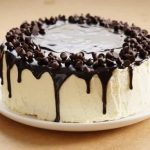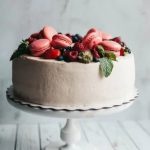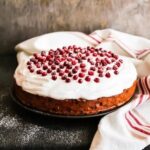Piping jelly is a versatile and vibrant tool that can take your cake decorating skills to the next level. In this article, we will explore how to decorate cake with piping jelly, offering step-by-step guidance on creating stunning designs and intricate patterns. Piping jelly adds a glossy finish and a pop of color to your cakes, making them truly stand out at any celebration.
Piping jelly is commonly used by bakers and pastry chefs to add intricate details, borders, and even text to cakes. It allows for precise control over the design and can be easily manipulated into various shapes and patterns. With the right techniques and tools, you can elevate your cake decorating game with the use of piping jelly.
In this comprehensive guide, we will discuss how to choose the right piping tips for different designs, prepare and color the piping jelly effectively, as well as provide tips for troubleshooting common issues that may arise during the decoration process.
Whether you are a beginner looking to enhance your skills or an experienced baker wanting to try something new, mastering the art of decorating cakes with piping jelly will undoubtedly impress your guests and add a professional touch to your creations.
Choosing the Right Piping Tips for Different Designs
Piping jelly is a versatile and fun way to decorate cakes, adding a pop of color and texture that can elevate your baked creations. One crucial aspect of using piping jelly effectively is choosing the right piping tips for different designs.
With the wide variety of piping tips available in the market, it can be overwhelming to select the best ones for your desired cake decorations. Here are some tips to help you choose the right piping tips for different designs.
Consider the Design You Want to Achieve
Before selecting a piping tip, consider the design you want to achieve on your cake. If you are aiming for intricate floral patterns or delicate lacework, a fine round tip or petal tip might be suitable. For writing messages or creating borders, a small plain round tip would work well. On the other hand, if you want to create bold stripes or stars, a larger open star or ribbon tip would be more appropriate.
Experiment With Different Piping Tips
Don’t be afraid to experiment with different piping tips to see which ones work best for your designs. Try practicing on a parchment paper or the back of a baking sheet before moving onto your actual cake. This way, you can get a feel for how each tip works and how much pressure you need to apply to achieve different effects. You may discover new techniques or combinations that result in unique and beautiful decorations for your cakes.
Invest in Quality Piping Tips
Quality matters when it comes to piping tips. Investing in good quality stainless steel piping tips can make a significant difference in the outcome of your cake decorations. They are more durable and provide consistent results compared to lower-quality plastic tips. With proper care and maintenance, good quality piping tips can last for years and help you create stunning designs on your cakes consistently.
By carefully choosing the right piping tips for different designs, you can enhance your cake decorating skills and create visually appealing treats that will impress your friends and family at any special occasion. Experimentation is key when it comes to mastering piping jelly techniques, so don’t hesitate to play around with various tips until you find what works best for your unique style and design preferences.
Preparing and Coloring the Piping Jelly
When it comes to choosing colors for your piping jelly, gel food colors are recommended as they are more concentrated than liquid food coloring and will not alter the consistency of the jelly. Start by adding a small amount of gel color at a time until you achieve your desired shade. Remember that piping jelly colors tend to deepen as they set, so opt for lighter shades if you are unsure.
To ensure that your colored piping jelly maintains its proper consistency, it is advisable to mix in a little cornstarch after adding the food coloring. This will help stabilize the jelly and prevent it from becoming too runny or sticky during the decorating process. With these simple steps, you can elevate your cake decorating skills by mastering how to decorate cakes with piping jelly effectively.
| Key Point | Detail |
|---|---|
| Heating Piping Jelly | Heat in microwave or on stovetop until smooth. |
| Choosing Gel Food Colors | Gel colors are recommended for vibrant shades. |
| Adding Cornstarch | Mix in cornstarch after coloring for stable consistency. |
Basic Techniques for Piping Jelly on Cakes
Piping jelly is a versatile and fun way to add decorative elements to your cakes. Whether you’re a beginner or an experienced baker, mastering the basic techniques for piping jelly on cakes is essential in creating beautiful designs. In this section, we will cover some fundamental methods to help you get started with using piping jelly in your cake decorating.
Preparing the Piping Jelly
Before you can start piping jelly on your cakes, it’s important to prepare the piping jelly properly. Make sure that the piping jelly is at the right consistency for piping – not too thick or too runny.
You can adjust the consistency by adding more powdered sugar for thicker jelly or more water for a thinner consistency. It’s also essential to work quickly once the piping jelly is ready, as it can harden and become difficult to pipe if left sitting for too long.
Basic Piping Techniques
One of the simplest ways to start decorating cakes with piping jelly is by using a round tip to create dots, lines, or borders on the cake. Practice maintaining consistent pressure while squeezing the pastry bag to ensure even lines and shapes. Another basic technique is creating simple swirls or rosettes by applying steady pressure while swirling the tip in a circular motion. Experiment with different tips and techniques to discover what works best for your designs.
Advanced Piping Jelly Techniques for Intricate Designs
Piping jelly is a versatile and creative way to decorate cakes, allowing for intricate designs that can truly elevate your baking creations. While basic piping techniques are essential, mastering advanced techniques can take your cake decorating skills to the next level. Here are some tips on how to achieve intricate designs using piping jelly.
One advanced technique for using piping jelly involves creating delicate lace designs on cakes. To do this, use a fine piping tip and a steady hand to pipe intricate lace patterns onto the surface of the cake. You can also mix different colors of piping jelly to create a visually stunning effect.
Another advanced technique is creating 3D elements on cakes using piping jelly. By layering different colors and shapes of jelly, you can create textured embellishments like flowers, leaves, or even miniature figurines.
When attempting advanced piping jelly techniques, it’s crucial to have a clear idea of the design you want to achieve before starting. Practice drawing the design on paper beforehand to ensure precision when piping onto the cake. Additionally, maintaining consistent pressure while piping is key to achieving smooth lines and even shapes. With practice and patience, you’ll be able to create show-stopping cakes adorned with intricate piping jelly designs.
| Advanced Piping Jelly Techniques | Intricate Designs on Cakes |
|---|---|
| Creating delicate lace patterns with fine piping tip | Enhancing visual appeal with mixed colors |
| Building 3D elements like flowers and leaves | Layering different shapes for texture |
Tips for Piping Jelly With Precision and Control
Piping jelly can be a fun and versatile tool for decorating cakes, but achieving precision and control can sometimes be challenging. To help you master the art of piping jelly with finesse, here are some tips to keep in mind:
- Choose the right consistency: Before starting to pipe, make sure your jelly is at the right consistency. If it’s too thin, your designs may lose shape, and if it’s too thick, it might be difficult to pipe smoothly. Adjust the consistency by adding more powdered sugar for thicker jelly or a few drops of water for a thinner consistency.
- Practice pressure control: One key to piping jelly with precision is mastering the pressure you apply while squeezing the piping bag. Practice on a spare piece of parchment paper to get a feel for how much pressure is needed to achieve different designs and lines.
- Use proper technique: To create clean lines and shapes, hold the piping bag at a 90-degree angle to the cake surface. Squeeze steadily and consistently while guiding the tip along your desired design path. Remember that slow and steady movements usually yield better results than rushing through the piping process.
In addition to these tips, having the right tools can also greatly improve your precision when working with piping jelly. Invest in quality piping tips in various sizes and shapes to expand your design possibilities and enhance your control over the decoration process.
With practice and patience, mastering precision and control when decorating cakes with piping jelly can elevate your creations to a whole new level of beauty and sophistication. Keep experimenting with different techniques and designs to find what works best for you, and soon enough, you’ll be able to create stunning cakes that are sure to impress any audience.
Troubleshooting Common Issues With Piping Jelly
When it comes to decorating cakes with piping jelly, there may be instances where you encounter some common issues that can affect the overall look of your design. Here are some tips on how to troubleshoot and overcome these challenges:
1. Clogged Piping Tips: If you find that your piping tip is getting clogged while using jelly, try clearing it out by gently squeezing the bag or using a toothpick to unclog any blockages. You can also warm up the jelly slightly to make it flow more smoothly.
2. Jelly Leaking: If you notice that the jelly is leaking out of the piping bag uncontrollably, it may be because the bag is overfilled or not sealed properly. Make sure to only fill the piping bag with a manageable amount of jelly and secure the closure tightly before piping.
3. Bubbles in Jelly: To avoid getting unwanted air bubbles in your piped designs, gently tap the piping bag on a flat surface to release any trapped air before starting to decorate your cake. You can also try using a thicker consistency of jelly to prevent bubbles from forming.
In order to achieve professional-looking decorations with piping jelly, it’s important to troubleshoot any issues that may arise during the decorating process. By following these tips, you can ensure that your cakes are beautifully decorated with precision and flair every time.
Creative Ideas for Decorating Cakes With Piping Jelly
Piping jelly is a versatile and fun tool to use when decorating cakes. Besides the basic techniques, there are endless creative possibilities for using piping jelly to take your cake decorating to the next level.
One creative idea is to create a watercolor effect on your cake by blending different colors of piping jelly together. Simply layer different colors onto the cake and then use a toothpick or small brush to gently swirl them together for a beautiful and artistic finish.
Another fun way to decorate cakes with piping jelly is to create 3D designs. By piping jelly onto parchment paper in various shapes and designs, allowing it to set, and then carefully peeling it off, you can create intricate decorations such as flowers, butterflies, or even words that can be placed on top of your cake. This technique adds depth and texture to your cakes, making them truly stand out.
For a more whimsical touch, try creating a stained glass effect using piping jelly. Simply pipe thin lines of different colored jelly onto the surface of your cake in a mosaic pattern. As the jelly sets, it will resemble the look of stained glass, adding an elegant and colorful element to your cake. Experiment with different color combinations and patterns to achieve the desired effect and impress your guests with your unique creation.
With these creative ideas for decorating cakes with piping jelly, you can elevate your cake decorating skills and impress everyone with your stunning creations. Whether you opt for a watercolor effect, 3D designs, or a stained glass look, piping jelly offers endless possibilities for adding beauty and personality to your cakes. So go ahead and unleash your creativity by exploring new ways to use piping jelly in your cake decorating projects.
Conclusion
In conclusion, mastering the art of decorating cakes with piping jelly can truly elevate your baking skills and impress your guests. Piping jelly offers a versatile and beautiful medium for creating intricate designs, patterns, and even three-dimensional decorations on your cakes. By following the tips and techniques outlined in this article, you can learn how to decorate cake with piping jelly with precision and control, turning simple homemade cakes into professional-looking works of art.
Whether you are a novice baker looking to explore new creative outlets or an experienced cake decorator seeking to expand your repertoire, piping jelly provides endless possibilities for customization and personalization. From elegant floral designs to whimsical characters, the only limit is your imagination. By choosing the right piping tips, preparing vibrant colors, and practicing basic and advanced techniques, you can achieve stunning results that will leave a lasting impression on anyone who sees (or tastes) your creations.
So next time you’re planning to bake a cake for a special occasion or simply want to indulge in some creative baking therapy, remember the beauty and versatility of piping jelly. Experiment with different designs, textures, and colors to discover what speaks to your style and preferences. With patience and practice, you’ll soon find yourself confidently decorating cakes with piping jelly like a pro – adding that extra touch of elegance and creativity to your sweet creations.
Frequently Asked Questions
How Do You Use Piping Gel in Cake Decorating?
Piping gel is commonly used in cake decorating to create a variety of effects. It can be used for writing messages, creating designs, or even attaching edible decorations. Its smooth consistency makes it easy to work with and it provides a glossy finish to the decorations.
Does Piping Gel Set Hard?
Piping gel does not set hard like some other cake decorating mediums. Instead, it remains soft and pliable, making it ideal for creating intricate designs that require flexibility. This characteristic also allows for easy manipulation of the decorations even after they have been placed on the cake.
How Do You Put Jelly Between Cake Layers?
To put jelly between cake layers, start by leveling off the top of each cake layer to create a flat surface. Spread a thin layer of jelly on top of one cake layer, ensuring that it reaches the edges.
Gently place the second cake layer on top and repeat the process if using more layers. The jelly will act as a filling between the layers, adding flavor and moisture to the cake when sliced.

Welcome to my blog about home and family. This blog is a place where I will share my thoughts, ideas, and experiences related to these important topics. I am a stay-at-home mom with two young children. I hope you enjoy reading it! and may find some helpful tips and ideas that will make your home and family life even better!





